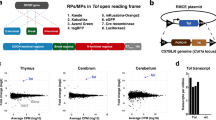Abstract
As a new approach to produce human proteins of therapeutic interest we have derived lymphoid cell lines expressing such proteins from transgenic mice, either by generating trans-hybridomas by cell fusion in vitro or by onc gene-mediated immortalisation in vivo of transgenic lymphocytes. The latter procedure could be applied to different cell types for the expression of proteins that require tissue-specific modifications.
This is a preview of subscription content, access via your institution
Access options
Subscribe to this journal
Receive 12 print issues and online access
$209.00 per year
only $17.42 per issue
Buy this article
- Purchase on Springer Link
- Instant access to full article PDF
Prices may be subject to local taxes which are calculated during checkout
Similar content being viewed by others
References
Yelton, D.E., Marguhes, D.H., Diamond, B., and Scharff, M.D. 1980. Plasmacytomas and hybridomas development and applications, p. 3–17. In: Monoclonal antibodies. Hybridomas: a new dimension in biological analyses. Kennet, R. H., McKearn, T. J., and Bechtol, K. B. (Eds). Plenum Press, New York and London.
Storb, U. 1987. Transgenic mice with immunoglobulin genes. Ann. Rev. Immunol. 5:151–174.
Babinet, C., Morello, D., Rougeot, C., and Rouyre, S. 1986. Transhybridomas from fusion gene transgenic lymphocytes can be used to produce foreign protein of biological interest. Eur. J. Immunol. 16:1033–1035.
Owen, M.C., Brennan, S.O., Lewis, J.H., and Carrell, R.W. 1983. Mutation of antitrypsin to antithrombin. α1-antitrypsin Pittsburgh (358 Met→Art), a fatal bleeding disorder. N. Engl. J. Med. 309:694–698.
Courtney, M., Jallat, S., Tessier, L.-H. et al. 1985. Synthesis in E. coli of α1-antitrypsin variants of therapeutic potential for emphysema and thrombosis. Nature 313:149–151.
Schapira, M., Ramus, M.-A., Jallat, S., Carvallo, D., and Courtney, M. 1986. Recombinant α1-antitrypsin Pittsburgh (Met358→Arg) is a potent inhibitor for plasma kallikrem and activated factor XII fragment. J. Clin. Invest. 77:635–637.
Thompson, A.R. 1986. Structure, function and molecular defects of factor IX. Blood 67:565–572.
De la Salle, H., Altenburger, W., Elkaim, R. et al. 1985. Active γ-carboxylated human factor IX expressed using recombinant DNA techniques. Nature 316:268–270.
Balland, A., Faure, T., Carvallo, D. et al. 1988. Characterization of two differently processed forms of human recombinant factor IX synthesized in CHO cells transformed with a polycistronic vector. Eur. J. Biochem. 172:565–572.
Garver, R.I., Chytil, A., Karlsson, S. et al. 1987. Production of glycosylated physiologically “normal” human α1-antitrypsin by mouse fibroblasts modified by insertion of a human α1-antitrypsin cDNA using a retroviral vector. Proc. Natl. Acad. Sci. USA 84:1050–1054.
Straight, D.L., Sherill, G.B., Noyes, C.M. et al. 1985. Structural and functional characteristics of activated human factor IX after chemical modification of γ-carboxyglutamic acid residues. J. Biol. Chem. 260:2890–2894.
Rabiet, M.-J., Jorgensen, M.J., Furie, B., and Furie, B.C. 1987. Effect of propeptide mutations on post-translational processing of factor IX. J. Biol. Chem. 262:14895–14898.
Banerji, J., Olson, L., and Schaffner, W. 1983. A lymphocyte-specific cellular enhancer is located downstream of the joining region in immunoglobulin heavy-chain genes. Cell 33:729–740.
Gillies, S.S., Morrison, S.L., Di, V.T., and Tonegawa, S. 1983. A tissue-specific transcription enhancer element is located in the major intron of a rearranged immunoglobulin heavy-chain gene. Cell 33:717–728.
Adams, J.M., Harris, C.A., Pinkert, L.M. et al. 1985. The c-myc oncogene driven by immunoglobulin enhancers induces lymphoid malignancy in transgenic mice. Nature 318:533–538.
Ornitz, D.M., Hammer, R.E., Messing, A., Palmiter, R.D., and Brinster, R.L. 1987. Pancreatic neoplasia induced by SV40 T-antigen expression in acinar cells of transgenic mice. Science 238:188–193.
Neuberger, M.S. 1983. Expression and regulation of immunoglobulin heavy-chain gene transfected into lymphoid cells. EMBO J. 2:1373–1378.
Bernard, O., Cory, S., Gerondakis, S., Webb, E., and Adams, J.M. 1983. Sequence of the murine and human cellular myc oncogenes and two modes of myc transcription resulting from chromosome translocation in B lymphoid tumours. EMBO J. 2:2375–2383.
Brinster, R.L., Chen, H.Y., Messing, A. et al. 1984. Transgenic harboring SV40 T-antigen genes develop characteristic brain tumours. Cell 37:367–379.
Weidle, U.H. and Buckel, P. 1987. Establishment of stable mouse myeloma cells constitutively secreting human tissue-type plasminogen activator. Gene 57:131–141.
Hendricks, M.B., Banker, M.J., and McLaughlin, M. 1988. A high-efficiency vector for expression of foreign genes in myeloma cells. Gene 64:43–51.
Suda, Y., Aizawa, S., Hirai, S. et al. 1987. Driven by the same Ig enhancer and SV40 T promoter ras induced lung adenomatous tumours, myc induced pre-B cell lymphomas and SV40 large T gene a variety of tumors in transgenic mice. EMBO J. 6:4055–4065.
Maniatis, F., Fritsch, F., and Sambrook, J. 1982. Molecular Cloning, a Laboratory Manual. Cold Spring Harbor Laboratory, Cold Spring Harbor, NY.
Kelley, D.E., Coleclough, C., and Perry, R.P. 1982. Functional significance and evolutionary development of the 5′-terminal regions of immunoglobulin variable-regions genes. Cell 29:681–689.
Krawinkel, U., Zoebelien, G., and Bothwell, A.L.M. 1986. Palindromic sequences are associated with sites of DNA breakage during gene conversion. Nucl. Acids Res. 14:3871–3882.
Chase, T. and Shaw, E. 1970. Titration of trypsin, plasmin and thrombin with p-nitrophenyl p′-guanidinobenzoate HC1. Methods Enzymol. 19:20–27.
Meunier, L., Allain, J.P., and Frommel, D. 1975. Performances of an artificial reagent for the one-stage factor IX assay. Thromb. Diath. Haemorrh. 33:547–552.
St. Groth, F.S. and Scheidegger, D. 1980. Production of monoclonal antibodies: strategy and tactics. J. Immunol. Methods 35:1–21.
Meulien, P., Faure, T., Mischler, F. et al. 1988. A new recombinant procoagulant protein derived from the cDNA encoding human FVIII. Protein Engineering 2:301–306.
Author information
Authors and Affiliations
Rights and permissions
About this article
Cite this article
Pavirani, A., Skern, T., Meur, M. et al. Recombinant Proteins of Therapeutic Interest Expressed by Lymphoid Cell Lines Derived from Transgenic Mice. Nat Biotechnol 7, 1049–1054 (1989). https://doi.org/10.1038/nbt1089-1049
Received:
Accepted:
Issue Date:
DOI: https://doi.org/10.1038/nbt1089-1049
This article is cited by
-
Recombinant human alpha-1 proteinase inhibitor: towards therapeutic use
Amino Acids (2006)



